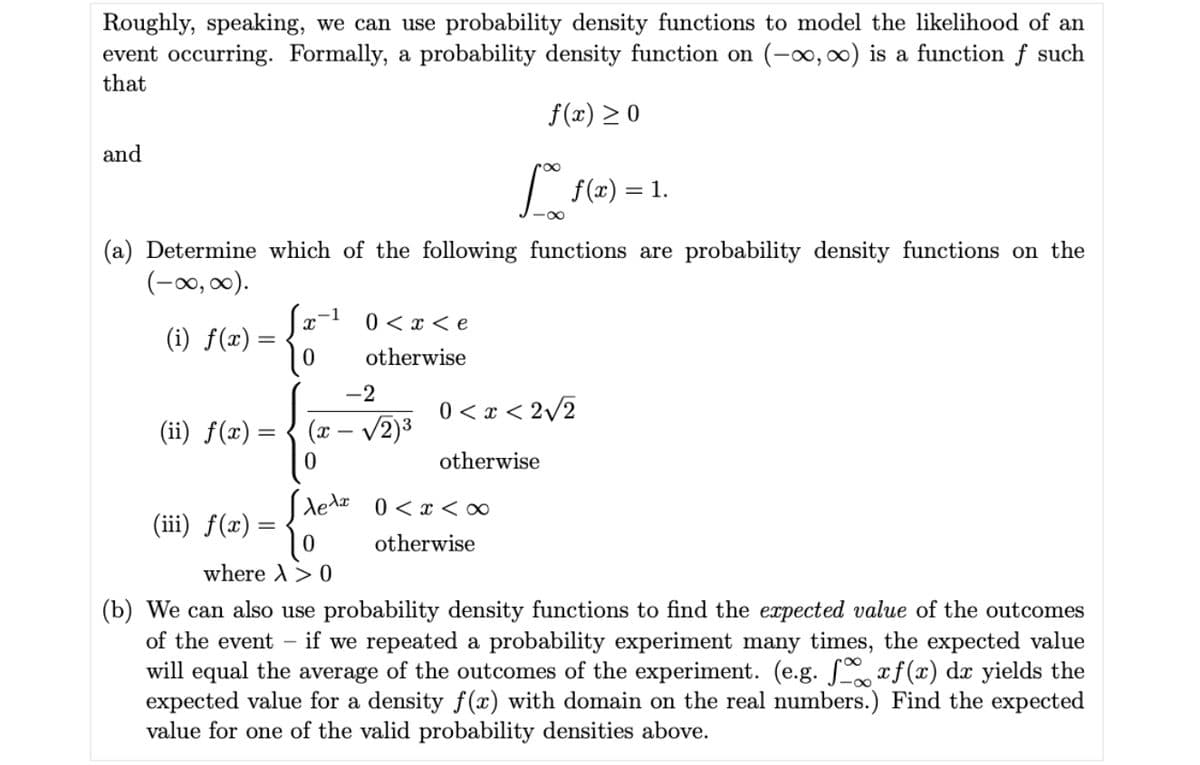oughly, speaking, we can use probability density functions to model the likelihood of an ent occurring. Formally, a probability density function on (-x, 0) is a function f such at f(x) >0 | f(2) = 1. ) Determine which of the following functions are probability density functions on the (-00, 00). x-1 0 0 ) We can also use probability density functions to find the expected value of the outcomes of the event - if we repeated a probability experiment many times, the expected value will equal the average of the outcomes of the experiment. (e.g. rf(x) d yields the expected value for a density f(x) with domain on the real numbers.) Find the expected value for one of the valid probability densities above.
oughly, speaking, we can use probability density functions to model the likelihood of an ent occurring. Formally, a probability density function on (-x, 0) is a function f such at f(x) >0 | f(2) = 1. ) Determine which of the following functions are probability density functions on the (-00, 00). x-1 0 0 ) We can also use probability density functions to find the expected value of the outcomes of the event - if we repeated a probability experiment many times, the expected value will equal the average of the outcomes of the experiment. (e.g. rf(x) d yields the expected value for a density f(x) with domain on the real numbers.) Find the expected value for one of the valid probability densities above.
MATLAB: An Introduction with Applications
6th Edition
ISBN:9781119256830
Author:Amos Gilat
Publisher:Amos Gilat
Chapter1: Starting With Matlab
Section: Chapter Questions
Problem 1P
Related questions
Question

Transcribed Image Text:Roughly, speaking, we can use probability density functions to model the likelihood of an
event occurring. Formally, a probability density function on (-, 0) is a function f such
that
f(x) > 0
and
| f(x) = 1.
-0-
(a) Determine which of the following functions are probability density functions on the
(-00, 00).
0 < x < e
(i) f(x) =
otherwise
-2
0 < x < 2/2
(ii) f(x) = { (x – v2)3
otherwise
Sledz
0 < x < ∞
(ii) f(x) =
otherwise
where A> 0
(b) We can also use probability density functions to find the expected value of the outcomes
of the event – if we repeated a probability experiment many times, the expected value
will equal the average of the outcomes of the experiment. (e.g. S xf (x) dx yields the
expected value for a density f (x) with domain on the real numbers.) Find the expected
value for one of the valid probability densities above.
Expert Solution
This question has been solved!
Explore an expertly crafted, step-by-step solution for a thorough understanding of key concepts.
Step by step
Solved in 2 steps with 1 images

Recommended textbooks for you

MATLAB: An Introduction with Applications
Statistics
ISBN:
9781119256830
Author:
Amos Gilat
Publisher:
John Wiley & Sons Inc

Probability and Statistics for Engineering and th…
Statistics
ISBN:
9781305251809
Author:
Jay L. Devore
Publisher:
Cengage Learning

Statistics for The Behavioral Sciences (MindTap C…
Statistics
ISBN:
9781305504912
Author:
Frederick J Gravetter, Larry B. Wallnau
Publisher:
Cengage Learning

MATLAB: An Introduction with Applications
Statistics
ISBN:
9781119256830
Author:
Amos Gilat
Publisher:
John Wiley & Sons Inc

Probability and Statistics for Engineering and th…
Statistics
ISBN:
9781305251809
Author:
Jay L. Devore
Publisher:
Cengage Learning

Statistics for The Behavioral Sciences (MindTap C…
Statistics
ISBN:
9781305504912
Author:
Frederick J Gravetter, Larry B. Wallnau
Publisher:
Cengage Learning

Elementary Statistics: Picturing the World (7th E…
Statistics
ISBN:
9780134683416
Author:
Ron Larson, Betsy Farber
Publisher:
PEARSON

The Basic Practice of Statistics
Statistics
ISBN:
9781319042578
Author:
David S. Moore, William I. Notz, Michael A. Fligner
Publisher:
W. H. Freeman

Introduction to the Practice of Statistics
Statistics
ISBN:
9781319013387
Author:
David S. Moore, George P. McCabe, Bruce A. Craig
Publisher:
W. H. Freeman